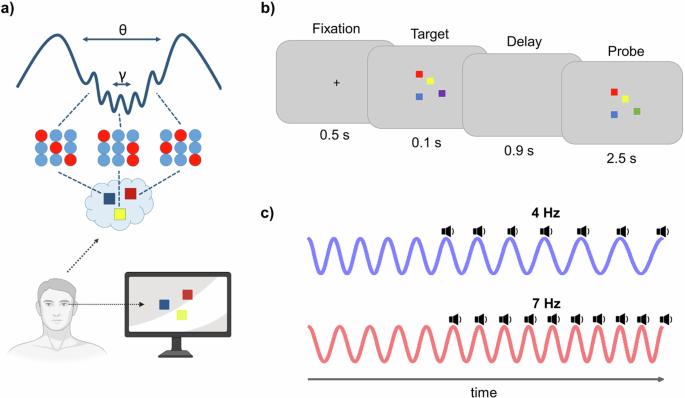Sensory stimulation enhances visual working memory capacity
引用次数: 0
Abstract
Visual working memory (vWM) plays a crucial role in visual information processing and higher cognitive functions; however, it has a very limited capacity. Recently, several studies have successfully modulated vWM capacity in humans using entrainment with transcranial alternate current stimulation (tACS) by targeting parietal theta in a frequency-specific manner. In the current study, we aim to expand upon these findings by utilizing sensory instead of electrical stimulation. Across six behavioral experiments (combined N = 209), we applied rhythmic visual and auditory sensory stimulation at 4 Hz and 7 Hz, aiming to modulate vWM capacity. Collectively, the results showed an overall robust improvement with sensory stimulation at either frequency, compared to baseline. However, contrary to our prediction, 7 Hz stimulation tended to slightly outperform 4 Hz stimulation. Importantly, the observed facilitatory effect was mainly driven by the low-capacity sub-group of participants. Follow-up experiments using the Attention Network Test (ANT) and pupillometry measures did not find evidence that this effect could be directly attributed to modulation of phasic or tonic arousal. We speculate that our results differed from those obtained with tACS due to targeting functionally different theta oscillations, or the modulation of participants’ temporal expectations. Visual or auditory stimulation at 4 Hz and 7 Hz improved visual working memory performance. This effect was more pronounced in individuals with lower visual working memory capacity.

感官刺激可增强视觉工作记忆能力
视觉工作记忆(vWM)在视觉信息处理和高级认知功能中起着至关重要的作用;然而,它的容量却非常有限。最近,有几项研究利用经颅交替电流刺激(tACS),以特定频率的方式针对顶叶θ,成功地调节了人类的视觉工作记忆能力。在当前的研究中,我们旨在利用感官刺激而不是电刺激来扩展这些发现。在六次行为实验(总人数= 209)中,我们分别采用了4赫兹和7赫兹的有节奏视觉和听觉感官刺激,旨在调节vWM能力。总的来说,实验结果表明,与基线相比,两种频率的感官刺激都能显著改善患者的记忆力。然而,与我们的预测相反,7赫兹刺激往往略优于4赫兹刺激。重要的是,观察到的促进作用主要是由低能力亚组参与者驱动的。使用注意力网络测试(ANT)和瞳孔测量法进行的后续实验没有发现证据表明,这种效应可直接归因于对阶段性或强直性唤醒的调节。我们推测,我们的结果与 tACS 的结果不同,是因为我们针对的是功能不同的 Theta 振荡,或者是对参与者时间预期的调节。4赫兹和7赫兹的视觉或听觉刺激提高了视觉工作记忆能力。这种效果在视觉工作记忆能力较低的个体中更为明显。
本文章由计算机程序翻译,如有差异,请以英文原文为准。
求助全文
约1分钟内获得全文
求助全文

 求助内容:
求助内容: 应助结果提醒方式:
应助结果提醒方式:


